Strategic Role of Charge Nurse Managers in Healthcare
VerifiedAdded on 2020/05/08
|11
|3532
|342
AI Summary
This analysis focuses on the pivotal role that charge nurse managers play in healthcare organizations. It delves into their responsibilities in leading nursing teams, fostering a positive organizational culture, and implementing strategies that enhance patient care quality. By examining various studies and frameworks, including those by McCallin and Frankson (2010) and Wager et al. (2017), the assignment highlights how effective management practices can lead to improved healthcare outcomes. The discussion also considers challenges faced by charge nurse managers in adapting to rapidly changing healthcare environments and suggests ways they can leverage their leadership roles to drive innovation and efficiency within their teams.
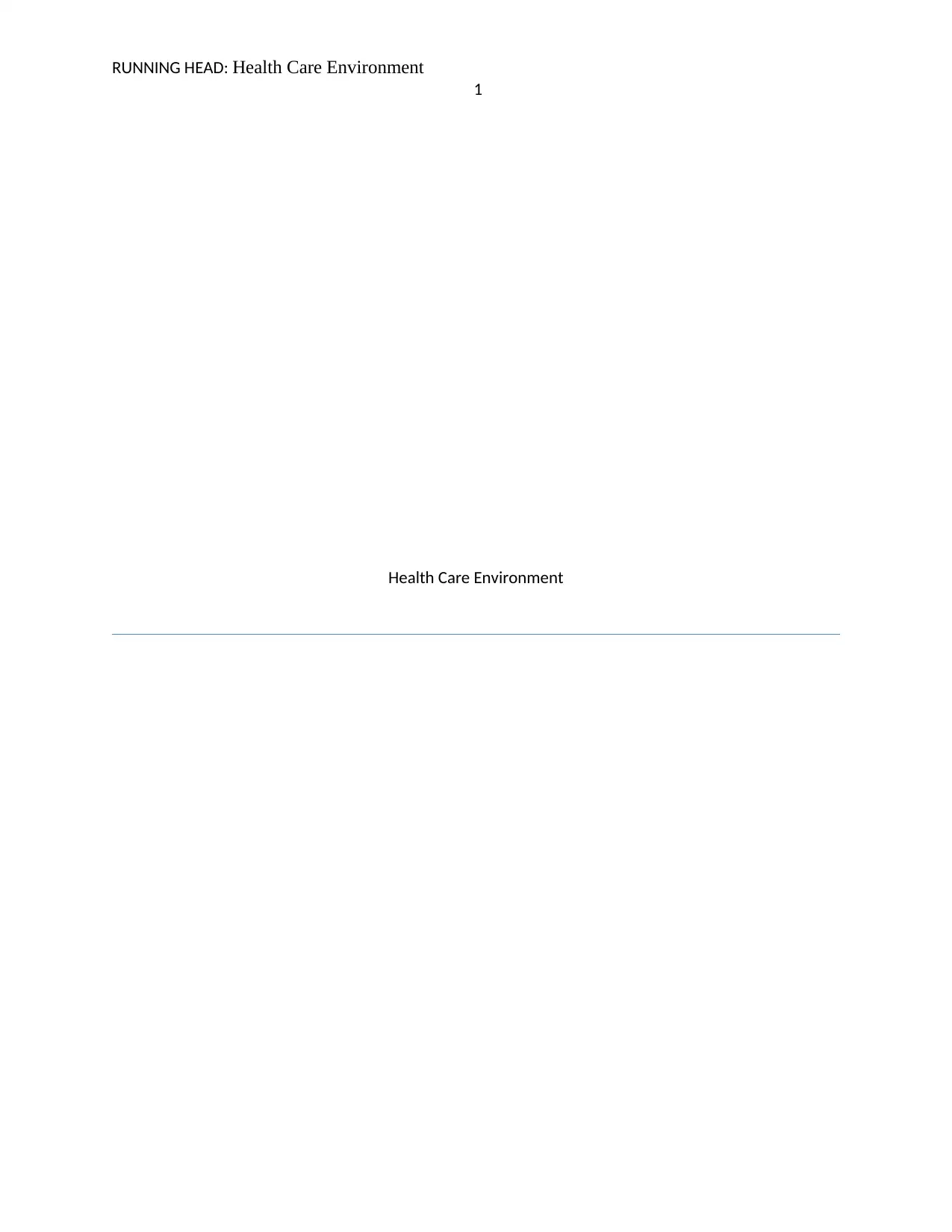
RUNNING HEAD: Health Care Environment
1
Health Care Environment
1
Health Care Environment
Paraphrase This Document
Need a fresh take? Get an instant paraphrase of this document with our AI Paraphraser
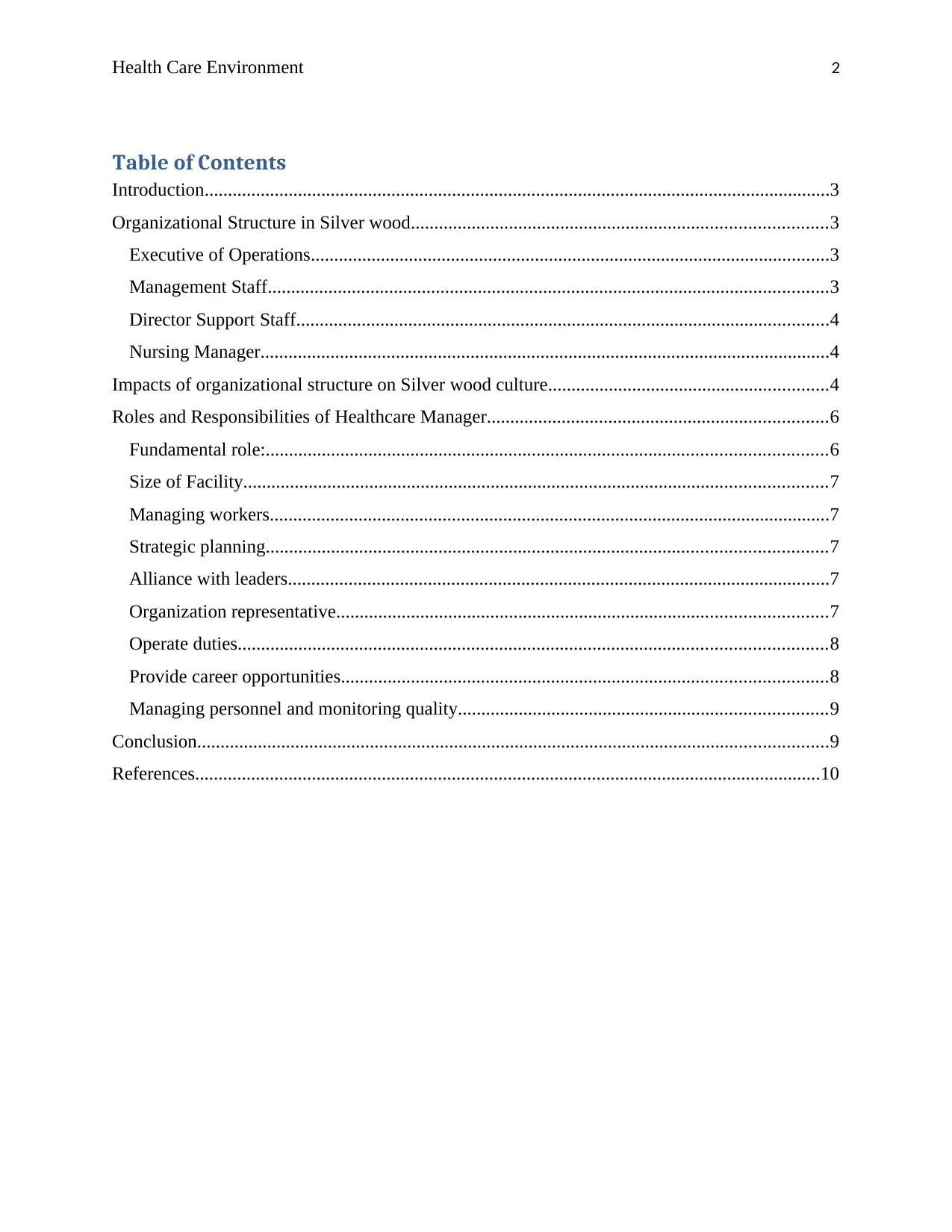
Health Care Environment 2
Table of Contents
Introduction......................................................................................................................................3
Organizational Structure in Silver wood.........................................................................................3
Executive of Operations...............................................................................................................3
Management Staff........................................................................................................................3
Director Support Staff..................................................................................................................4
Nursing Manager..........................................................................................................................4
Impacts of organizational structure on Silver wood culture............................................................4
Roles and Responsibilities of Healthcare Manager.........................................................................6
Fundamental role:........................................................................................................................6
Size of Facility.............................................................................................................................7
Managing workers........................................................................................................................7
Strategic planning........................................................................................................................7
Alliance with leaders....................................................................................................................7
Organization representative.........................................................................................................7
Operate duties..............................................................................................................................8
Provide career opportunities........................................................................................................8
Managing personnel and monitoring quality...............................................................................9
Conclusion.......................................................................................................................................9
References......................................................................................................................................10
Table of Contents
Introduction......................................................................................................................................3
Organizational Structure in Silver wood.........................................................................................3
Executive of Operations...............................................................................................................3
Management Staff........................................................................................................................3
Director Support Staff..................................................................................................................4
Nursing Manager..........................................................................................................................4
Impacts of organizational structure on Silver wood culture............................................................4
Roles and Responsibilities of Healthcare Manager.........................................................................6
Fundamental role:........................................................................................................................6
Size of Facility.............................................................................................................................7
Managing workers........................................................................................................................7
Strategic planning........................................................................................................................7
Alliance with leaders....................................................................................................................7
Organization representative.........................................................................................................7
Operate duties..............................................................................................................................8
Provide career opportunities........................................................................................................8
Managing personnel and monitoring quality...............................................................................9
Conclusion.......................................................................................................................................9
References......................................................................................................................................10
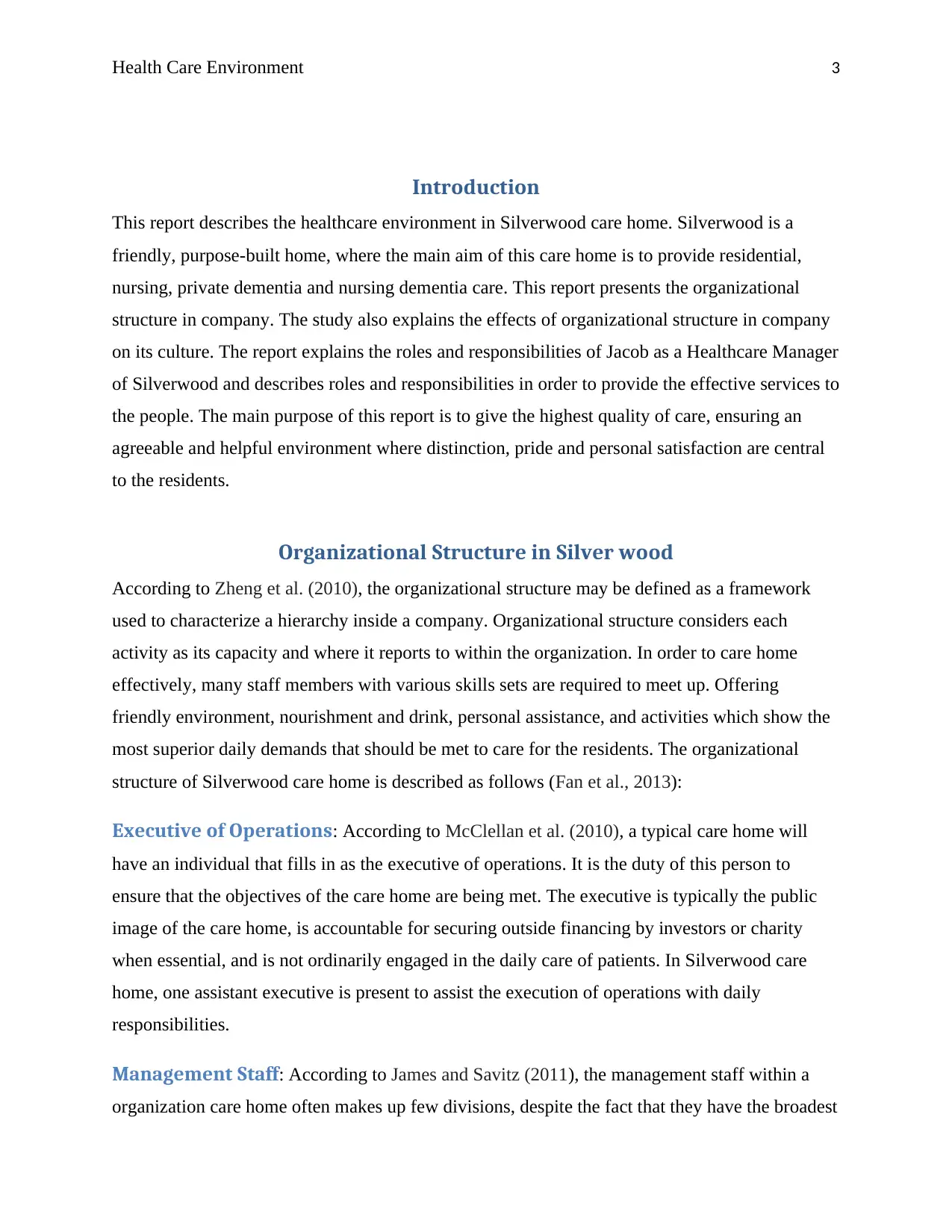
Health Care Environment 3
Introduction
This report describes the healthcare environment in Silverwood care home. Silverwood is a
friendly, purpose-built home, where the main aim of this care home is to provide residential,
nursing, private dementia and nursing dementia care. This report presents the organizational
structure in company. The study also explains the effects of organizational structure in company
on its culture. The report explains the roles and responsibilities of Jacob as a Healthcare Manager
of Silverwood and describes roles and responsibilities in order to provide the effective services to
the people. The main purpose of this report is to give the highest quality of care, ensuring an
agreeable and helpful environment where distinction, pride and personal satisfaction are central
to the residents.
Organizational Structure in Silver wood
According to Zheng et al. (2010), the organizational structure may be defined as a framework
used to characterize a hierarchy inside a company. Organizational structure considers each
activity as its capacity and where it reports to within the organization. In order to care home
effectively, many staff members with various skills sets are required to meet up. Offering
friendly environment, nourishment and drink, personal assistance, and activities which show the
most superior daily demands that should be met to care for the residents. The organizational
structure of Silverwood care home is described as follows (Fan et al., 2013):
Executive of Operations: According to McClellan et al. (2010), a typical care home will
have an individual that fills in as the executive of operations. It is the duty of this person to
ensure that the objectives of the care home are being met. The executive is typically the public
image of the care home, is accountable for securing outside financing by investors or charity
when essential, and is not ordinarily engaged in the daily care of patients. In Silverwood care
home, one assistant executive is present to assist the execution of operations with daily
responsibilities.
Management Staff: According to James and Savitz (2011), the management staff within a
organization care home often makes up few divisions, despite the fact that they have the broadest
Introduction
This report describes the healthcare environment in Silverwood care home. Silverwood is a
friendly, purpose-built home, where the main aim of this care home is to provide residential,
nursing, private dementia and nursing dementia care. This report presents the organizational
structure in company. The study also explains the effects of organizational structure in company
on its culture. The report explains the roles and responsibilities of Jacob as a Healthcare Manager
of Silverwood and describes roles and responsibilities in order to provide the effective services to
the people. The main purpose of this report is to give the highest quality of care, ensuring an
agreeable and helpful environment where distinction, pride and personal satisfaction are central
to the residents.
Organizational Structure in Silver wood
According to Zheng et al. (2010), the organizational structure may be defined as a framework
used to characterize a hierarchy inside a company. Organizational structure considers each
activity as its capacity and where it reports to within the organization. In order to care home
effectively, many staff members with various skills sets are required to meet up. Offering
friendly environment, nourishment and drink, personal assistance, and activities which show the
most superior daily demands that should be met to care for the residents. The organizational
structure of Silverwood care home is described as follows (Fan et al., 2013):
Executive of Operations: According to McClellan et al. (2010), a typical care home will
have an individual that fills in as the executive of operations. It is the duty of this person to
ensure that the objectives of the care home are being met. The executive is typically the public
image of the care home, is accountable for securing outside financing by investors or charity
when essential, and is not ordinarily engaged in the daily care of patients. In Silverwood care
home, one assistant executive is present to assist the execution of operations with daily
responsibilities.
Management Staff: According to James and Savitz (2011), the management staff within a
organization care home often makes up few divisions, despite the fact that they have the broadest
⊘ This is a preview!⊘
Do you want full access?
Subscribe today to unlock all pages.

Trusted by 1+ million students worldwide
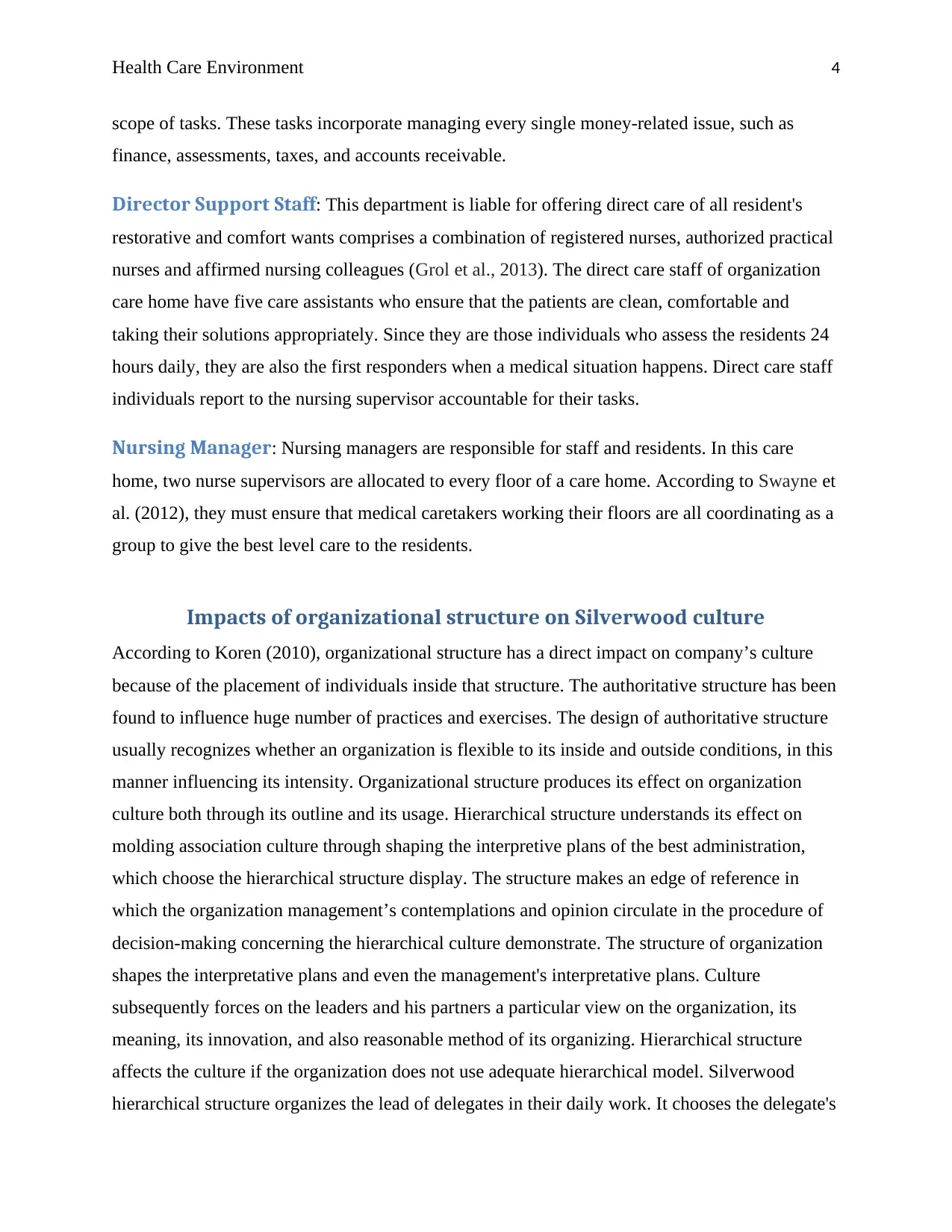
Health Care Environment 4
scope of tasks. These tasks incorporate managing every single money-related issue, such as
finance, assessments, taxes, and accounts receivable.
Director Support Staff: This department is liable for offering direct care of all resident's
restorative and comfort wants comprises a combination of registered nurses, authorized practical
nurses and affirmed nursing colleagues (Grol et al., 2013). The direct care staff of organization
care home have five care assistants who ensure that the patients are clean, comfortable and
taking their solutions appropriately. Since they are those individuals who assess the residents 24
hours daily, they are also the first responders when a medical situation happens. Direct care staff
individuals report to the nursing supervisor accountable for their tasks.
Nursing Manager: Nursing managers are responsible for staff and residents. In this care
home, two nurse supervisors are allocated to every floor of a care home. According to Swayne et
al. (2012), they must ensure that medical caretakers working their floors are all coordinating as a
group to give the best level care to the residents.
Impacts of organizational structure on Silverwood culture
According to Koren (2010), organizational structure has a direct impact on company’s culture
because of the placement of individuals inside that structure. The authoritative structure has been
found to influence huge number of practices and exercises. The design of authoritative structure
usually recognizes whether an organization is flexible to its inside and outside conditions, in this
manner influencing its intensity. Organizational structure produces its effect on organization
culture both through its outline and its usage. Hierarchical structure understands its effect on
molding association culture through shaping the interpretive plans of the best administration,
which choose the hierarchical structure display. The structure makes an edge of reference in
which the organization management’s contemplations and opinion circulate in the procedure of
decision-making concerning the hierarchical culture demonstrate. The structure of organization
shapes the interpretative plans and even the management's interpretative plans. Culture
subsequently forces on the leaders and his partners a particular view on the organization, its
meaning, its innovation, and also reasonable method of its organizing. Hierarchical structure
affects the culture if the organization does not use adequate hierarchical model. Silverwood
hierarchical structure organizes the lead of delegates in their daily work. It chooses the delegate's
scope of tasks. These tasks incorporate managing every single money-related issue, such as
finance, assessments, taxes, and accounts receivable.
Director Support Staff: This department is liable for offering direct care of all resident's
restorative and comfort wants comprises a combination of registered nurses, authorized practical
nurses and affirmed nursing colleagues (Grol et al., 2013). The direct care staff of organization
care home have five care assistants who ensure that the patients are clean, comfortable and
taking their solutions appropriately. Since they are those individuals who assess the residents 24
hours daily, they are also the first responders when a medical situation happens. Direct care staff
individuals report to the nursing supervisor accountable for their tasks.
Nursing Manager: Nursing managers are responsible for staff and residents. In this care
home, two nurse supervisors are allocated to every floor of a care home. According to Swayne et
al. (2012), they must ensure that medical caretakers working their floors are all coordinating as a
group to give the best level care to the residents.
Impacts of organizational structure on Silverwood culture
According to Koren (2010), organizational structure has a direct impact on company’s culture
because of the placement of individuals inside that structure. The authoritative structure has been
found to influence huge number of practices and exercises. The design of authoritative structure
usually recognizes whether an organization is flexible to its inside and outside conditions, in this
manner influencing its intensity. Organizational structure produces its effect on organization
culture both through its outline and its usage. Hierarchical structure understands its effect on
molding association culture through shaping the interpretive plans of the best administration,
which choose the hierarchical structure display. The structure makes an edge of reference in
which the organization management’s contemplations and opinion circulate in the procedure of
decision-making concerning the hierarchical culture demonstrate. The structure of organization
shapes the interpretative plans and even the management's interpretative plans. Culture
subsequently forces on the leaders and his partners a particular view on the organization, its
meaning, its innovation, and also reasonable method of its organizing. Hierarchical structure
affects the culture if the organization does not use adequate hierarchical model. Silverwood
hierarchical structure organizes the lead of delegates in their daily work. It chooses the delegate's
Paraphrase This Document
Need a fresh take? Get an instant paraphrase of this document with our AI Paraphraser
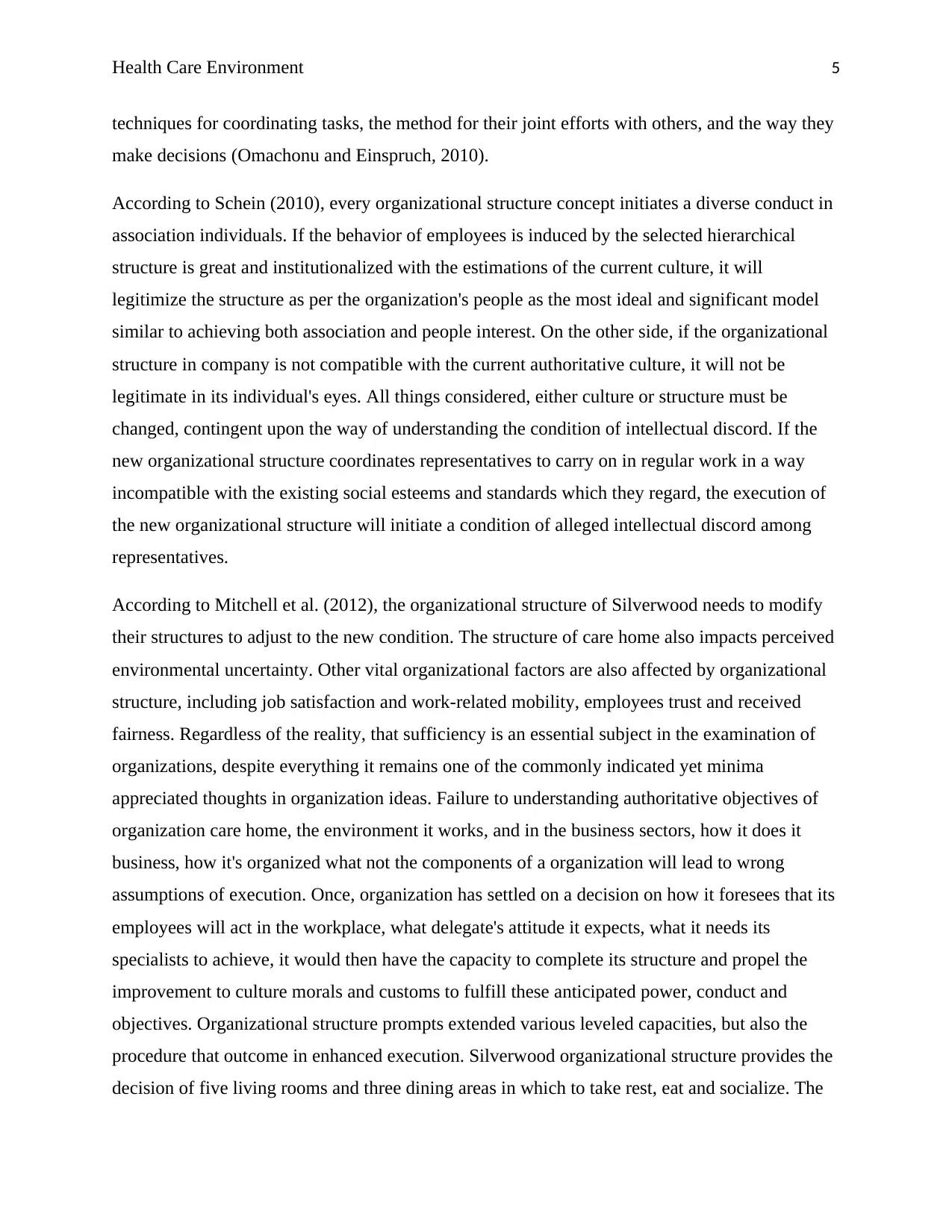
Health Care Environment 5
techniques for coordinating tasks, the method for their joint efforts with others, and the way they
make decisions (Omachonu and Einspruch, 2010).
According to Schein (2010), every organizational structure concept initiates a diverse conduct in
association individuals. If the behavior of employees is induced by the selected hierarchical
structure is great and institutionalized with the estimations of the current culture, it will
legitimize the structure as per the organization's people as the most ideal and significant model
similar to achieving both association and people interest. On the other side, if the organizational
structure in company is not compatible with the current authoritative culture, it will not be
legitimate in its individual's eyes. All things considered, either culture or structure must be
changed, contingent upon the way of understanding the condition of intellectual discord. If the
new organizational structure coordinates representatives to carry on in regular work in a way
incompatible with the existing social esteems and standards which they regard, the execution of
the new organizational structure will initiate a condition of alleged intellectual discord among
representatives.
According to Mitchell et al. (2012), the organizational structure of Silverwood needs to modify
their structures to adjust to the new condition. The structure of care home also impacts perceived
environmental uncertainty. Other vital organizational factors are also affected by organizational
structure, including job satisfaction and work-related mobility, employees trust and received
fairness. Regardless of the reality, that sufficiency is an essential subject in the examination of
organizations, despite everything it remains one of the commonly indicated yet minima
appreciated thoughts in organization ideas. Failure to understanding authoritative objectives of
organization care home, the environment it works, and in the business sectors, how it does it
business, how it's organized what not the components of a organization will lead to wrong
assumptions of execution. Once, organization has settled on a decision on how it foresees that its
employees will act in the workplace, what delegate's attitude it expects, what it needs its
specialists to achieve, it would then have the capacity to complete its structure and propel the
improvement to culture morals and customs to fulfill these anticipated power, conduct and
objectives. Organizational structure prompts extended various leveled capacities, but also the
procedure that outcome in enhanced execution. Silverwood organizational structure provides the
decision of five living rooms and three dining areas in which to take rest, eat and socialize. The
techniques for coordinating tasks, the method for their joint efforts with others, and the way they
make decisions (Omachonu and Einspruch, 2010).
According to Schein (2010), every organizational structure concept initiates a diverse conduct in
association individuals. If the behavior of employees is induced by the selected hierarchical
structure is great and institutionalized with the estimations of the current culture, it will
legitimize the structure as per the organization's people as the most ideal and significant model
similar to achieving both association and people interest. On the other side, if the organizational
structure in company is not compatible with the current authoritative culture, it will not be
legitimate in its individual's eyes. All things considered, either culture or structure must be
changed, contingent upon the way of understanding the condition of intellectual discord. If the
new organizational structure coordinates representatives to carry on in regular work in a way
incompatible with the existing social esteems and standards which they regard, the execution of
the new organizational structure will initiate a condition of alleged intellectual discord among
representatives.
According to Mitchell et al. (2012), the organizational structure of Silverwood needs to modify
their structures to adjust to the new condition. The structure of care home also impacts perceived
environmental uncertainty. Other vital organizational factors are also affected by organizational
structure, including job satisfaction and work-related mobility, employees trust and received
fairness. Regardless of the reality, that sufficiency is an essential subject in the examination of
organizations, despite everything it remains one of the commonly indicated yet minima
appreciated thoughts in organization ideas. Failure to understanding authoritative objectives of
organization care home, the environment it works, and in the business sectors, how it does it
business, how it's organized what not the components of a organization will lead to wrong
assumptions of execution. Once, organization has settled on a decision on how it foresees that its
employees will act in the workplace, what delegate's attitude it expects, what it needs its
specialists to achieve, it would then have the capacity to complete its structure and propel the
improvement to culture morals and customs to fulfill these anticipated power, conduct and
objectives. Organizational structure prompts extended various leveled capacities, but also the
procedure that outcome in enhanced execution. Silverwood organizational structure provides the
decision of five living rooms and three dining areas in which to take rest, eat and socialize. The
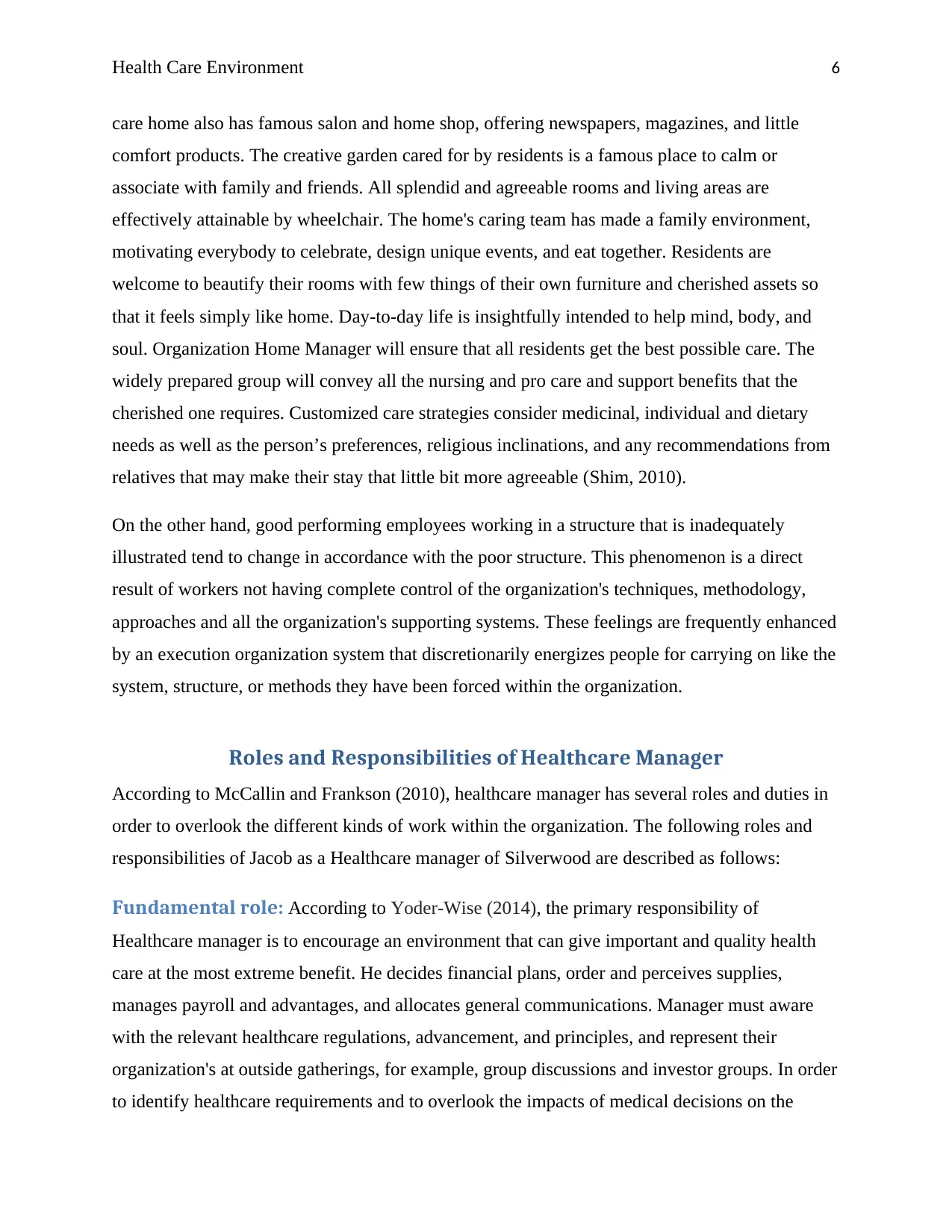
Health Care Environment 6
care home also has famous salon and home shop, offering newspapers, magazines, and little
comfort products. The creative garden cared for by residents is a famous place to calm or
associate with family and friends. All splendid and agreeable rooms and living areas are
effectively attainable by wheelchair. The home's caring team has made a family environment,
motivating everybody to celebrate, design unique events, and eat together. Residents are
welcome to beautify their rooms with few things of their own furniture and cherished assets so
that it feels simply like home. Day-to-day life is insightfully intended to help mind, body, and
soul. Organization Home Manager will ensure that all residents get the best possible care. The
widely prepared group will convey all the nursing and pro care and support benefits that the
cherished one requires. Customized care strategies consider medicinal, individual and dietary
needs as well as the person’s preferences, religious inclinations, and any recommendations from
relatives that may make their stay that little bit more agreeable (Shim, 2010).
On the other hand, good performing employees working in a structure that is inadequately
illustrated tend to change in accordance with the poor structure. This phenomenon is a direct
result of workers not having complete control of the organization's techniques, methodology,
approaches and all the organization's supporting systems. These feelings are frequently enhanced
by an execution organization system that discretionarily energizes people for carrying on like the
system, structure, or methods they have been forced within the organization.
Roles and Responsibilities of Healthcare Manager
According to McCallin and Frankson (2010), healthcare manager has several roles and duties in
order to overlook the different kinds of work within the organization. The following roles and
responsibilities of Jacob as a Healthcare manager of Silverwood are described as follows:
Fundamental role: According to Yoder-Wise (2014), the primary responsibility of
Healthcare manager is to encourage an environment that can give important and quality health
care at the most extreme benefit. He decides financial plans, order and perceives supplies,
manages payroll and advantages, and allocates general communications. Manager must aware
with the relevant healthcare regulations, advancement, and principles, and represent their
organization's at outside gatherings, for example, group discussions and investor groups. In order
to identify healthcare requirements and to overlook the impacts of medical decisions on the
care home also has famous salon and home shop, offering newspapers, magazines, and little
comfort products. The creative garden cared for by residents is a famous place to calm or
associate with family and friends. All splendid and agreeable rooms and living areas are
effectively attainable by wheelchair. The home's caring team has made a family environment,
motivating everybody to celebrate, design unique events, and eat together. Residents are
welcome to beautify their rooms with few things of their own furniture and cherished assets so
that it feels simply like home. Day-to-day life is insightfully intended to help mind, body, and
soul. Organization Home Manager will ensure that all residents get the best possible care. The
widely prepared group will convey all the nursing and pro care and support benefits that the
cherished one requires. Customized care strategies consider medicinal, individual and dietary
needs as well as the person’s preferences, religious inclinations, and any recommendations from
relatives that may make their stay that little bit more agreeable (Shim, 2010).
On the other hand, good performing employees working in a structure that is inadequately
illustrated tend to change in accordance with the poor structure. This phenomenon is a direct
result of workers not having complete control of the organization's techniques, methodology,
approaches and all the organization's supporting systems. These feelings are frequently enhanced
by an execution organization system that discretionarily energizes people for carrying on like the
system, structure, or methods they have been forced within the organization.
Roles and Responsibilities of Healthcare Manager
According to McCallin and Frankson (2010), healthcare manager has several roles and duties in
order to overlook the different kinds of work within the organization. The following roles and
responsibilities of Jacob as a Healthcare manager of Silverwood are described as follows:
Fundamental role: According to Yoder-Wise (2014), the primary responsibility of
Healthcare manager is to encourage an environment that can give important and quality health
care at the most extreme benefit. He decides financial plans, order and perceives supplies,
manages payroll and advantages, and allocates general communications. Manager must aware
with the relevant healthcare regulations, advancement, and principles, and represent their
organization's at outside gatherings, for example, group discussions and investor groups. In order
to identify healthcare requirements and to overlook the impacts of medical decisions on the
⊘ This is a preview!⊘
Do you want full access?
Subscribe today to unlock all pages.

Trusted by 1+ million students worldwide
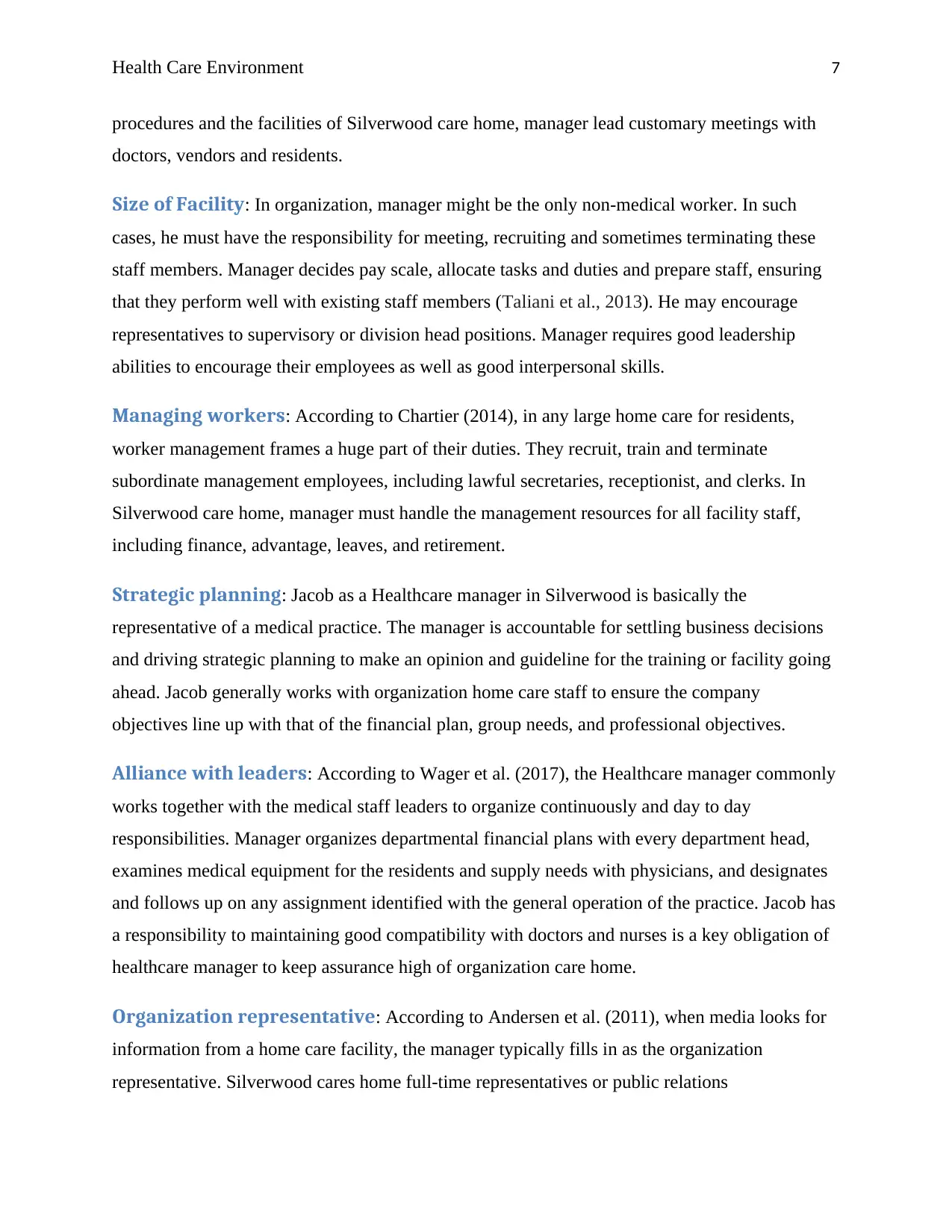
Health Care Environment 7
procedures and the facilities of Silverwood care home, manager lead customary meetings with
doctors, vendors and residents.
Size of Facility: In organization, manager might be the only non-medical worker. In such
cases, he must have the responsibility for meeting, recruiting and sometimes terminating these
staff members. Manager decides pay scale, allocate tasks and duties and prepare staff, ensuring
that they perform well with existing staff members (Taliani et al., 2013). He may encourage
representatives to supervisory or division head positions. Manager requires good leadership
abilities to encourage their employees as well as good interpersonal skills.
Managing workers: According to Chartier (2014), in any large home care for residents,
worker management frames a huge part of their duties. They recruit, train and terminate
subordinate management employees, including lawful secretaries, receptionist, and clerks. In
Silverwood care home, manager must handle the management resources for all facility staff,
including finance, advantage, leaves, and retirement.
Strategic planning: Jacob as a Healthcare manager in Silverwood is basically the
representative of a medical practice. The manager is accountable for settling business decisions
and driving strategic planning to make an opinion and guideline for the training or facility going
ahead. Jacob generally works with organization home care staff to ensure the company
objectives line up with that of the financial plan, group needs, and professional objectives.
Alliance with leaders: According to Wager et al. (2017), the Healthcare manager commonly
works together with the medical staff leaders to organize continuously and day to day
responsibilities. Manager organizes departmental financial plans with every department head,
examines medical equipment for the residents and supply needs with physicians, and designates
and follows up on any assignment identified with the general operation of the practice. Jacob has
a responsibility to maintaining good compatibility with doctors and nurses is a key obligation of
healthcare manager to keep assurance high of organization care home.
Organization representative: According to Andersen et al. (2011), when media looks for
information from a home care facility, the manager typically fills in as the organization
representative. Silverwood cares home full-time representatives or public relations
procedures and the facilities of Silverwood care home, manager lead customary meetings with
doctors, vendors and residents.
Size of Facility: In organization, manager might be the only non-medical worker. In such
cases, he must have the responsibility for meeting, recruiting and sometimes terminating these
staff members. Manager decides pay scale, allocate tasks and duties and prepare staff, ensuring
that they perform well with existing staff members (Taliani et al., 2013). He may encourage
representatives to supervisory or division head positions. Manager requires good leadership
abilities to encourage their employees as well as good interpersonal skills.
Managing workers: According to Chartier (2014), in any large home care for residents,
worker management frames a huge part of their duties. They recruit, train and terminate
subordinate management employees, including lawful secretaries, receptionist, and clerks. In
Silverwood care home, manager must handle the management resources for all facility staff,
including finance, advantage, leaves, and retirement.
Strategic planning: Jacob as a Healthcare manager in Silverwood is basically the
representative of a medical practice. The manager is accountable for settling business decisions
and driving strategic planning to make an opinion and guideline for the training or facility going
ahead. Jacob generally works with organization home care staff to ensure the company
objectives line up with that of the financial plan, group needs, and professional objectives.
Alliance with leaders: According to Wager et al. (2017), the Healthcare manager commonly
works together with the medical staff leaders to organize continuously and day to day
responsibilities. Manager organizes departmental financial plans with every department head,
examines medical equipment for the residents and supply needs with physicians, and designates
and follows up on any assignment identified with the general operation of the practice. Jacob has
a responsibility to maintaining good compatibility with doctors and nurses is a key obligation of
healthcare manager to keep assurance high of organization care home.
Organization representative: According to Andersen et al. (2011), when media looks for
information from a home care facility, the manager typically fills in as the organization
representative. Silverwood cares home full-time representatives or public relations
Paraphrase This Document
Need a fresh take? Get an instant paraphrase of this document with our AI Paraphraser
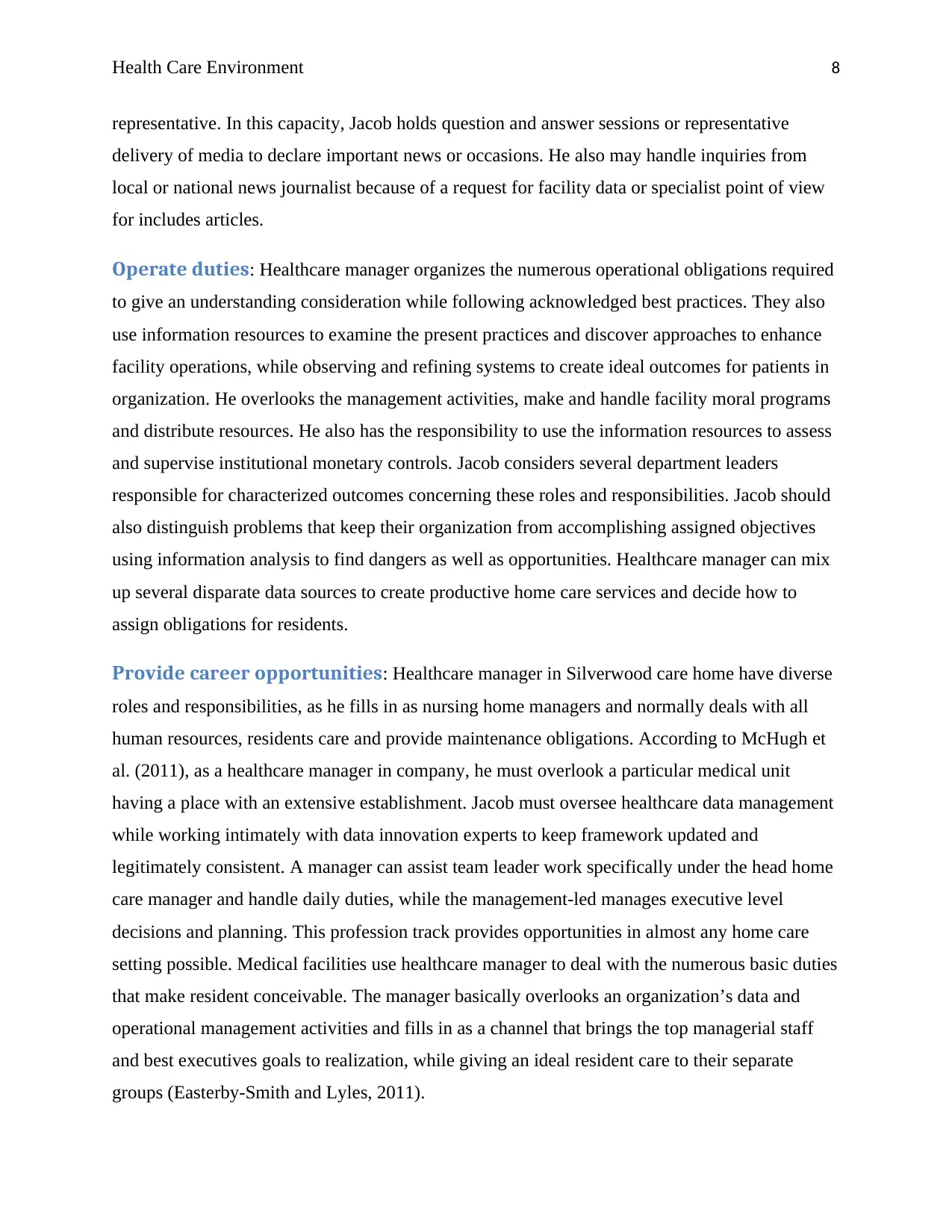
Health Care Environment 8
representative. In this capacity, Jacob holds question and answer sessions or representative
delivery of media to declare important news or occasions. He also may handle inquiries from
local or national news journalist because of a request for facility data or specialist point of view
for includes articles.
Operate duties: Healthcare manager organizes the numerous operational obligations required
to give an understanding consideration while following acknowledged best practices. They also
use information resources to examine the present practices and discover approaches to enhance
facility operations, while observing and refining systems to create ideal outcomes for patients in
organization. He overlooks the management activities, make and handle facility moral programs
and distribute resources. He also has the responsibility to use the information resources to assess
and supervise institutional monetary controls. Jacob considers several department leaders
responsible for characterized outcomes concerning these roles and responsibilities. Jacob should
also distinguish problems that keep their organization from accomplishing assigned objectives
using information analysis to find dangers as well as opportunities. Healthcare manager can mix
up several disparate data sources to create productive home care services and decide how to
assign obligations for residents.
Provide career opportunities: Healthcare manager in Silverwood care home have diverse
roles and responsibilities, as he fills in as nursing home managers and normally deals with all
human resources, residents care and provide maintenance obligations. According to McHugh et
al. (2011), as a healthcare manager in company, he must overlook a particular medical unit
having a place with an extensive establishment. Jacob must oversee healthcare data management
while working intimately with data innovation experts to keep framework updated and
legitimately consistent. A manager can assist team leader work specifically under the head home
care manager and handle daily duties, while the management-led manages executive level
decisions and planning. This profession track provides opportunities in almost any home care
setting possible. Medical facilities use healthcare manager to deal with the numerous basic duties
that make resident conceivable. The manager basically overlooks an organization’s data and
operational management activities and fills in as a channel that brings the top managerial staff
and best executives goals to realization, while giving an ideal resident care to their separate
groups (Easterby-Smith and Lyles, 2011).
representative. In this capacity, Jacob holds question and answer sessions or representative
delivery of media to declare important news or occasions. He also may handle inquiries from
local or national news journalist because of a request for facility data or specialist point of view
for includes articles.
Operate duties: Healthcare manager organizes the numerous operational obligations required
to give an understanding consideration while following acknowledged best practices. They also
use information resources to examine the present practices and discover approaches to enhance
facility operations, while observing and refining systems to create ideal outcomes for patients in
organization. He overlooks the management activities, make and handle facility moral programs
and distribute resources. He also has the responsibility to use the information resources to assess
and supervise institutional monetary controls. Jacob considers several department leaders
responsible for characterized outcomes concerning these roles and responsibilities. Jacob should
also distinguish problems that keep their organization from accomplishing assigned objectives
using information analysis to find dangers as well as opportunities. Healthcare manager can mix
up several disparate data sources to create productive home care services and decide how to
assign obligations for residents.
Provide career opportunities: Healthcare manager in Silverwood care home have diverse
roles and responsibilities, as he fills in as nursing home managers and normally deals with all
human resources, residents care and provide maintenance obligations. According to McHugh et
al. (2011), as a healthcare manager in company, he must overlook a particular medical unit
having a place with an extensive establishment. Jacob must oversee healthcare data management
while working intimately with data innovation experts to keep framework updated and
legitimately consistent. A manager can assist team leader work specifically under the head home
care manager and handle daily duties, while the management-led manages executive level
decisions and planning. This profession track provides opportunities in almost any home care
setting possible. Medical facilities use healthcare manager to deal with the numerous basic duties
that make resident conceivable. The manager basically overlooks an organization’s data and
operational management activities and fills in as a channel that brings the top managerial staff
and best executives goals to realization, while giving an ideal resident care to their separate
groups (Easterby-Smith and Lyles, 2011).
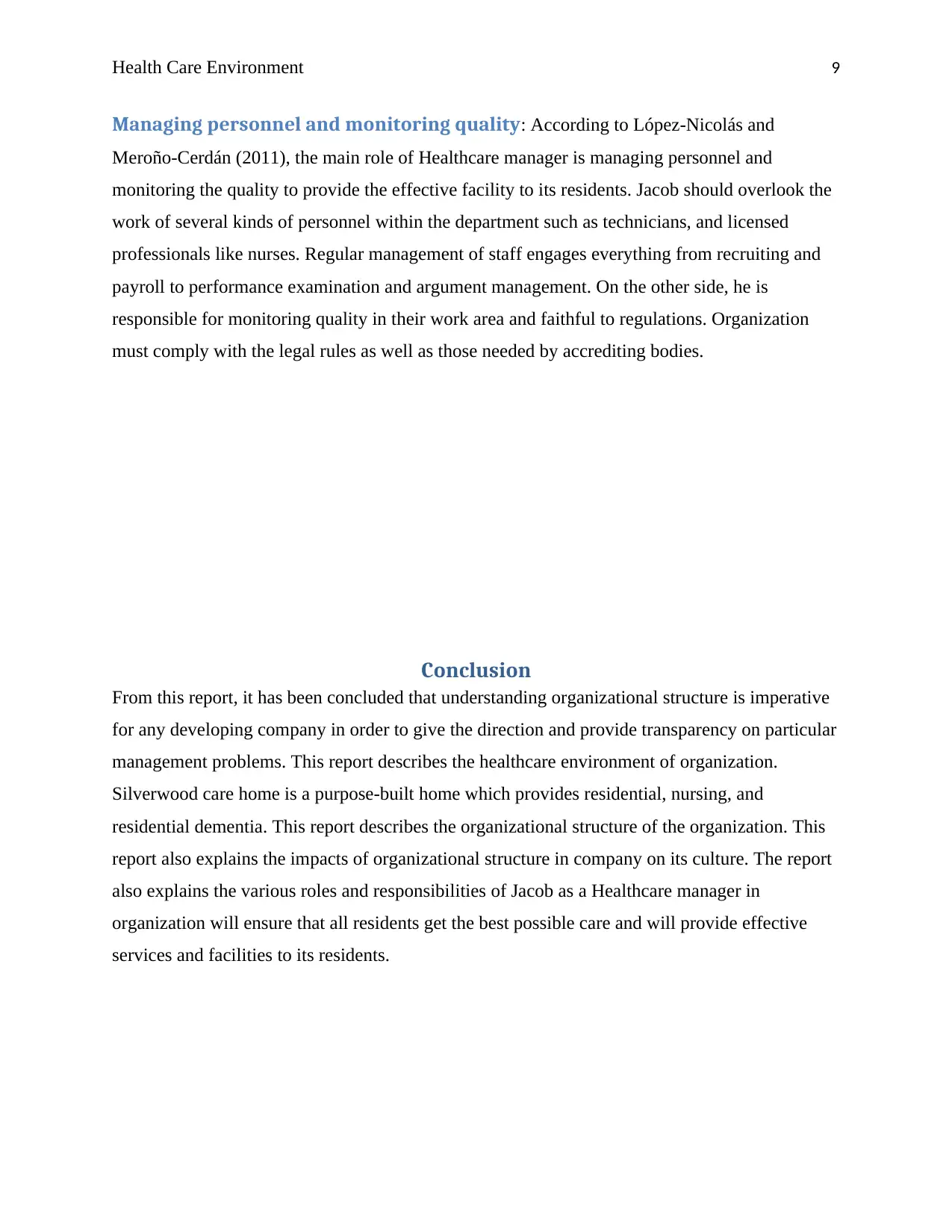
Health Care Environment 9
Managing personnel and monitoring quality: According to López-Nicolás and
Meroño-Cerdán (2011), the main role of Healthcare manager is managing personnel and
monitoring the quality to provide the effective facility to its residents. Jacob should overlook the
work of several kinds of personnel within the department such as technicians, and licensed
professionals like nurses. Regular management of staff engages everything from recruiting and
payroll to performance examination and argument management. On the other side, he is
responsible for monitoring quality in their work area and faithful to regulations. Organization
must comply with the legal rules as well as those needed by accrediting bodies.
Conclusion
From this report, it has been concluded that understanding organizational structure is imperative
for any developing company in order to give the direction and provide transparency on particular
management problems. This report describes the healthcare environment of organization.
Silverwood care home is a purpose-built home which provides residential, nursing, and
residential dementia. This report describes the organizational structure of the organization. This
report also explains the impacts of organizational structure in company on its culture. The report
also explains the various roles and responsibilities of Jacob as a Healthcare manager in
organization will ensure that all residents get the best possible care and will provide effective
services and facilities to its residents.
Managing personnel and monitoring quality: According to López-Nicolás and
Meroño-Cerdán (2011), the main role of Healthcare manager is managing personnel and
monitoring the quality to provide the effective facility to its residents. Jacob should overlook the
work of several kinds of personnel within the department such as technicians, and licensed
professionals like nurses. Regular management of staff engages everything from recruiting and
payroll to performance examination and argument management. On the other side, he is
responsible for monitoring quality in their work area and faithful to regulations. Organization
must comply with the legal rules as well as those needed by accrediting bodies.
Conclusion
From this report, it has been concluded that understanding organizational structure is imperative
for any developing company in order to give the direction and provide transparency on particular
management problems. This report describes the healthcare environment of organization.
Silverwood care home is a purpose-built home which provides residential, nursing, and
residential dementia. This report describes the organizational structure of the organization. This
report also explains the impacts of organizational structure in company on its culture. The report
also explains the various roles and responsibilities of Jacob as a Healthcare manager in
organization will ensure that all residents get the best possible care and will provide effective
services and facilities to its residents.
⊘ This is a preview!⊘
Do you want full access?
Subscribe today to unlock all pages.

Trusted by 1+ million students worldwide
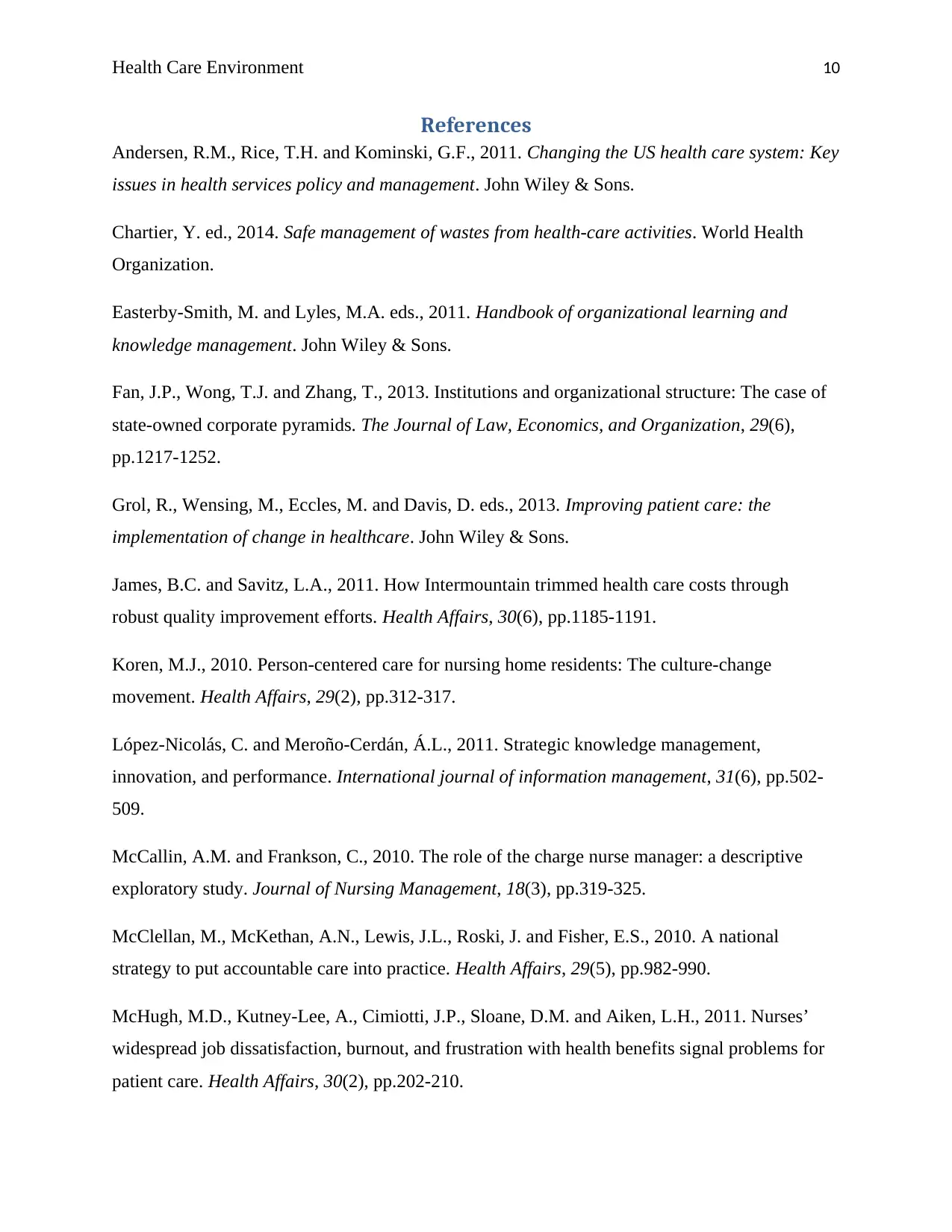
Health Care Environment 10
References
Andersen, R.M., Rice, T.H. and Kominski, G.F., 2011. Changing the US health care system: Key
issues in health services policy and management. John Wiley & Sons.
Chartier, Y. ed., 2014. Safe management of wastes from health-care activities. World Health
Organization.
Easterby-Smith, M. and Lyles, M.A. eds., 2011. Handbook of organizational learning and
knowledge management. John Wiley & Sons.
Fan, J.P., Wong, T.J. and Zhang, T., 2013. Institutions and organizational structure: The case of
state-owned corporate pyramids. The Journal of Law, Economics, and Organization, 29(6),
pp.1217-1252.
Grol, R., Wensing, M., Eccles, M. and Davis, D. eds., 2013. Improving patient care: the
implementation of change in healthcare. John Wiley & Sons.
James, B.C. and Savitz, L.A., 2011. How Intermountain trimmed health care costs through
robust quality improvement efforts. Health Affairs, 30(6), pp.1185-1191.
Koren, M.J., 2010. Person-centered care for nursing home residents: The culture-change
movement. Health Affairs, 29(2), pp.312-317.
López-Nicolás, C. and Meroño-Cerdán, Á.L., 2011. Strategic knowledge management,
innovation, and performance. International journal of information management, 31(6), pp.502-
509.
McCallin, A.M. and Frankson, C., 2010. The role of the charge nurse manager: a descriptive
exploratory study. Journal of Nursing Management, 18(3), pp.319-325.
McClellan, M., McKethan, A.N., Lewis, J.L., Roski, J. and Fisher, E.S., 2010. A national
strategy to put accountable care into practice. Health Affairs, 29(5), pp.982-990.
McHugh, M.D., Kutney-Lee, A., Cimiotti, J.P., Sloane, D.M. and Aiken, L.H., 2011. Nurses’
widespread job dissatisfaction, burnout, and frustration with health benefits signal problems for
patient care. Health Affairs, 30(2), pp.202-210.
References
Andersen, R.M., Rice, T.H. and Kominski, G.F., 2011. Changing the US health care system: Key
issues in health services policy and management. John Wiley & Sons.
Chartier, Y. ed., 2014. Safe management of wastes from health-care activities. World Health
Organization.
Easterby-Smith, M. and Lyles, M.A. eds., 2011. Handbook of organizational learning and
knowledge management. John Wiley & Sons.
Fan, J.P., Wong, T.J. and Zhang, T., 2013. Institutions and organizational structure: The case of
state-owned corporate pyramids. The Journal of Law, Economics, and Organization, 29(6),
pp.1217-1252.
Grol, R., Wensing, M., Eccles, M. and Davis, D. eds., 2013. Improving patient care: the
implementation of change in healthcare. John Wiley & Sons.
James, B.C. and Savitz, L.A., 2011. How Intermountain trimmed health care costs through
robust quality improvement efforts. Health Affairs, 30(6), pp.1185-1191.
Koren, M.J., 2010. Person-centered care for nursing home residents: The culture-change
movement. Health Affairs, 29(2), pp.312-317.
López-Nicolás, C. and Meroño-Cerdán, Á.L., 2011. Strategic knowledge management,
innovation, and performance. International journal of information management, 31(6), pp.502-
509.
McCallin, A.M. and Frankson, C., 2010. The role of the charge nurse manager: a descriptive
exploratory study. Journal of Nursing Management, 18(3), pp.319-325.
McClellan, M., McKethan, A.N., Lewis, J.L., Roski, J. and Fisher, E.S., 2010. A national
strategy to put accountable care into practice. Health Affairs, 29(5), pp.982-990.
McHugh, M.D., Kutney-Lee, A., Cimiotti, J.P., Sloane, D.M. and Aiken, L.H., 2011. Nurses’
widespread job dissatisfaction, burnout, and frustration with health benefits signal problems for
patient care. Health Affairs, 30(2), pp.202-210.
Paraphrase This Document
Need a fresh take? Get an instant paraphrase of this document with our AI Paraphraser
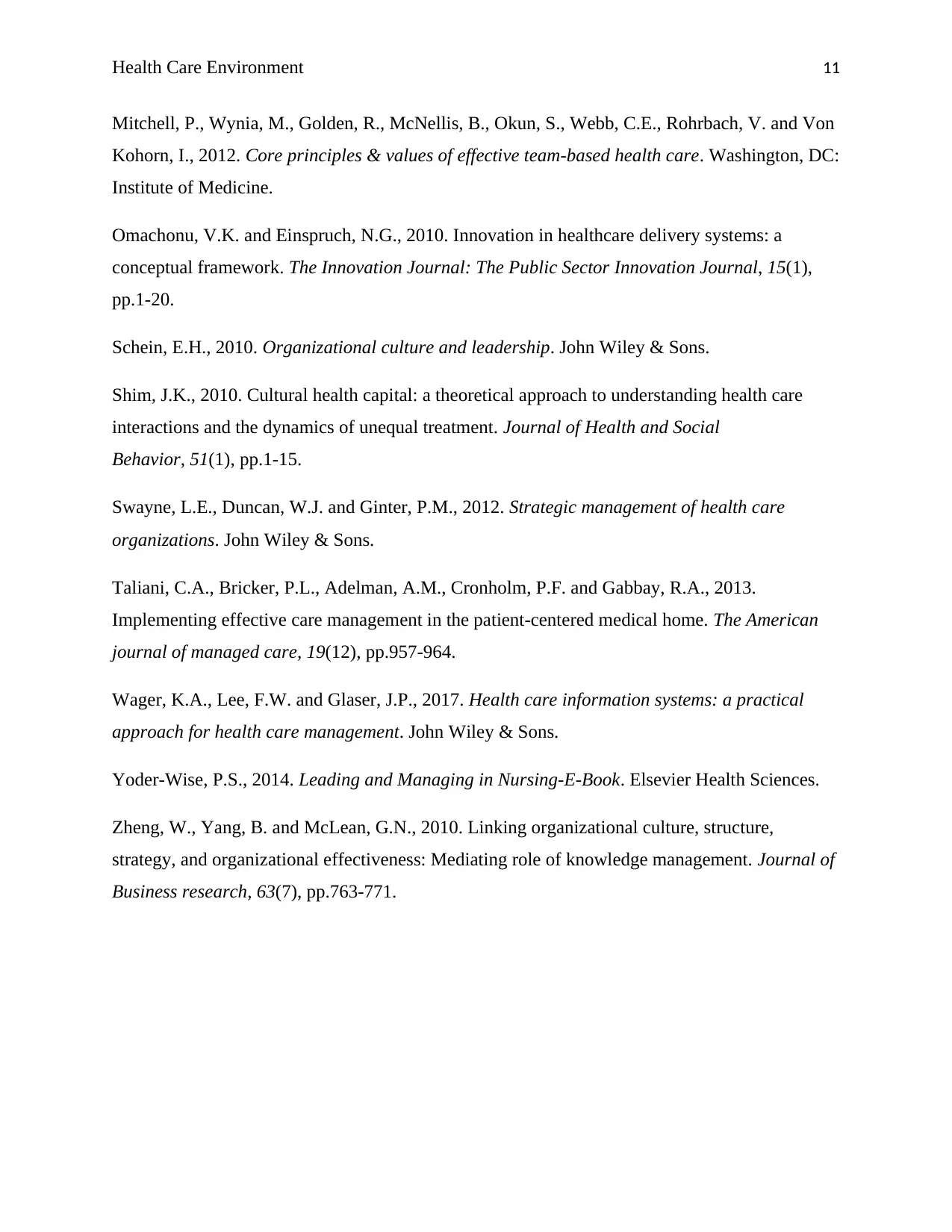
Health Care Environment 11
Mitchell, P., Wynia, M., Golden, R., McNellis, B., Okun, S., Webb, C.E., Rohrbach, V. and Von
Kohorn, I., 2012. Core principles & values of effective team-based health care. Washington, DC:
Institute of Medicine.
Omachonu, V.K. and Einspruch, N.G., 2010. Innovation in healthcare delivery systems: a
conceptual framework. The Innovation Journal: The Public Sector Innovation Journal, 15(1),
pp.1-20.
Schein, E.H., 2010. Organizational culture and leadership. John Wiley & Sons.
Shim, J.K., 2010. Cultural health capital: a theoretical approach to understanding health care
interactions and the dynamics of unequal treatment. Journal of Health and Social
Behavior, 51(1), pp.1-15.
Swayne, L.E., Duncan, W.J. and Ginter, P.M., 2012. Strategic management of health care
organizations. John Wiley & Sons.
Taliani, C.A., Bricker, P.L., Adelman, A.M., Cronholm, P.F. and Gabbay, R.A., 2013.
Implementing effective care management in the patient-centered medical home. The American
journal of managed care, 19(12), pp.957-964.
Wager, K.A., Lee, F.W. and Glaser, J.P., 2017. Health care information systems: a practical
approach for health care management. John Wiley & Sons.
Yoder-Wise, P.S., 2014. Leading and Managing in Nursing-E-Book. Elsevier Health Sciences.
Zheng, W., Yang, B. and McLean, G.N., 2010. Linking organizational culture, structure,
strategy, and organizational effectiveness: Mediating role of knowledge management. Journal of
Business research, 63(7), pp.763-771.
Mitchell, P., Wynia, M., Golden, R., McNellis, B., Okun, S., Webb, C.E., Rohrbach, V. and Von
Kohorn, I., 2012. Core principles & values of effective team-based health care. Washington, DC:
Institute of Medicine.
Omachonu, V.K. and Einspruch, N.G., 2010. Innovation in healthcare delivery systems: a
conceptual framework. The Innovation Journal: The Public Sector Innovation Journal, 15(1),
pp.1-20.
Schein, E.H., 2010. Organizational culture and leadership. John Wiley & Sons.
Shim, J.K., 2010. Cultural health capital: a theoretical approach to understanding health care
interactions and the dynamics of unequal treatment. Journal of Health and Social
Behavior, 51(1), pp.1-15.
Swayne, L.E., Duncan, W.J. and Ginter, P.M., 2012. Strategic management of health care
organizations. John Wiley & Sons.
Taliani, C.A., Bricker, P.L., Adelman, A.M., Cronholm, P.F. and Gabbay, R.A., 2013.
Implementing effective care management in the patient-centered medical home. The American
journal of managed care, 19(12), pp.957-964.
Wager, K.A., Lee, F.W. and Glaser, J.P., 2017. Health care information systems: a practical
approach for health care management. John Wiley & Sons.
Yoder-Wise, P.S., 2014. Leading and Managing in Nursing-E-Book. Elsevier Health Sciences.
Zheng, W., Yang, B. and McLean, G.N., 2010. Linking organizational culture, structure,
strategy, and organizational effectiveness: Mediating role of knowledge management. Journal of
Business research, 63(7), pp.763-771.
1 out of 11
Related Documents
Your All-in-One AI-Powered Toolkit for Academic Success.
+13062052269
info@desklib.com
Available 24*7 on WhatsApp / Email
![[object Object]](/_next/static/media/star-bottom.7253800d.svg)
Unlock your academic potential
Copyright © 2020–2025 A2Z Services. All Rights Reserved. Developed and managed by ZUCOL.





